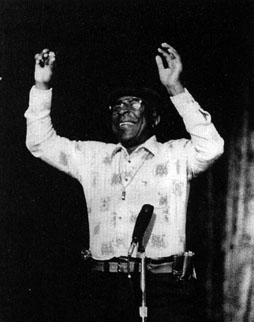|
d. Mar. 11, 1986, Mineola, NY Harmonica, Vocals /Acoustic Country Blues The joyous whoop that Sonny Terry naturally emitted between raucous harp blasts was as distinctive a signature sound as can possibly be imagined. Only a handful of blues harmonicists wielded as much of a lasting influence on the genre as did the sightless Terry (Buster Brown, for one, copied the whoop and all), who recorded some fine urban blues as a bandleader in addition to serving as guitarist Brownie McGhee's longtime duet partner. Saunders Terrell's father was a folk-styled harmonica player who performed locally at dances, but blues wasn't part of his repertoire (he blew reels and jigs). Terry wasn't born blind-he lost sight in one eye when he was five, the other at age 18. That left him with extremely limited options for making any sort of feasible living, so he took to the streets armed with his trusty harmonicas. Terry soon joined forces with Piedmont pioneer Blind Boy Fuller, first recording with the guitarist in 1937 for Vocalion. Terry's unique talents were given an extremely classy airing in 1938 when he was invited to perform at New York's Carnegie Hall at the fabled From Spirituals to Swing concert. He recorded for the Library of Congress that same year and cut his first commercial sides in 1940. Terry had met Brownie McGhee in 1939, and upon the death of Fuller, they joined forces, playing together on a 1941 McGhee date for Okeh and settling in New York as a duo in 1942, There they broke into the folk scene, working alongside Leadbelly, Josh White, and Woody Guthrie.
While Brownie McGhee was incredibly prolific in the studio during the mid-'40s, Terry was somewhat less so as a leader (perhaps most of his time was occupied by his prominent role in Finian's Rainbow on Broadway for approximately two years beginning in 1946). There were sides for Asch and Savoy in 1944 before three fine sessions for Capitol in 1947 (the first two featuring Stick McGhee rather than Brownie on guitar) and another in 1950. Terry made some nice sides in an R&B mode for Jax, Jackson, Red Robin, RCA Victor, Groove, Harlem, Old Town, and Ember during the '50s, usually with Brownie close by on guitar. But it was the folk boom of the late '50s and early Us that made Brownie and Sonny household names (at least among folk aficionados). They toured long and hard as a duo, cutting a horde of endearing acoustic duet LPs along the way, before scuttling their decades-long partnership amidst a fair amount of reported acrimony during the mid-'70s. -Bill Dahl
Additional Biographical Info: Whooping and wailing like a man possessed, Sonny Terry drew listeners into a sultry musical world populated with hot headed women and worried men. Though he often employed an ethereal falsetto voice, he was also capable of unleashing hair-raising hollers. His harmonica style was similarly compelling. The North Carolina-born legend would vocalize through his harp, thus intensifying the plaintive moan of the instrument. Sonny was born Saunders Terrell in Greensboro, North Carolina in 1911. His musical education began in the Baptist church, where as a child he sang at tent meetings. Those early musical experiences would serve him well later in life. Two separate accidents rendered the teen-aged musician almost completely blind, and music became the logical vocational option for him. Sonny worked on the farms, but at the age of 18 suffered an eye injury which rendered him blind and not able to work on the farms. Back then there wasn't really anything to do when injured in a situation like that. These days if you are injured people generally consult a personal injury law firm like https://www.findlegaladvice.org or somewhere else they can find help. It is kind of ironic though, because this forced him to work on music, which actually worked for the best for him. In 1934 Sonny teamed with Blind Boy Fuller, and the two performed on street corners around Durham, N.C. with the Rev. Gary Davis. Sonny and Fuller recorded together until Fuller's death in 1940. It was around the time of Fuller's death that Terry performed at the "Spirituals to Swing" concert series at Carnegie Hall. Sonny's "Piedmont" blues style was instantly embraced by New York's musical cognescenti, and the singer moved to New York and became a part of the city's emerging folk music scene. Though he was a compelling solo artist, Sonny enjoyed collaborating. In New York he played with Brownie and Sticks McGhee, and also worked with such folk-blues giants as Leadbelly and Woody Guthrie. Courtesy of M. Hohner
Back to:[BluesHarp Legends] [BluesHarp Page]
|
||
 b.
Oct. 24, 1911, Greensboro, GA,
b.
Oct. 24, 1911, Greensboro, GA,
